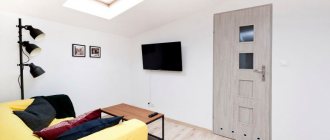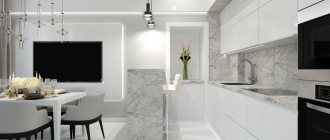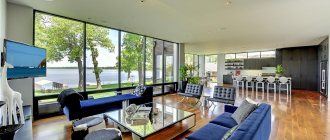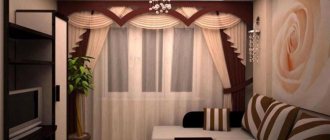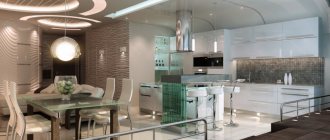Having a separate room for meals is a luxury that is unaffordable for many. So you have to work with all your might to turn your tiny kitchen into something more comfortable and attractive for the household, start remodeling and develop the design of the living room dining room, which will very soon appear in the house.
living room dining room design in light colors
Uniting space
A room with this layout is a combination of dining and guest areas. A kitchen is often adjacent to it, but its space, in this situation, is perceived as a secondary component of the overall decor. The key point in designing a single living room dining room will be the creation of a truly harmonious space, which, in addition to general stylistic features, will have clear zoning.
the sofa acts as a functional separator between the living and dining areas
The dining-living room in the apartment can be organized in the room for receiving guests, in areas combined with the kitchen, or in a specially designated room in the house.
An atmosphere of peace, comfort, coziness should reign in it - only in this case the newly appeared room will become a favorite gathering place for all household members. To cope with this task, you will have to work hard on the design of the future living room dining room: fill the decor with non-trivial accessories, furnish it with original furniture, and also provide the space with the right lighting .
Zoning
If we have already noted the importance of proper zoning, then it would be appropriate to develop this topic. Blindly following fashion, copying ready-made solutions for your living space with different technical parameters is not the best solution
Ideally, make an individual design project for a living room combined with a kitchen, which will eliminate a set of typical problems and ensure the correct distribution of all the necessary zones in relation to the wishes of the residents.
Zoning begins with redevelopment
As a rule, the emphasis is on the junction of two zones, where it is important to either completely remove the partition or some specific part of it. Most often, the partition is completely demolished, and in its place the following can serve as a zone delimiter:
- a big sofa;
- bar counter;
- island or peninsula;
- the partition is not up to the ceiling;
- dinner table.
A kitchen with a bar counter as a delimiter is a kind of gold standard, but it is recommended to make the counter wider if the space around it allows. In this case, it can be used as a full-fledged dining table, and modern bar stools are no less comfortable than ordinary ones.
Due to practical features, only moisture- and heat-resistant materials should be used to decorate the kitchen area, for example:
- ceramic tiles or porcelain stoneware;
- strained glass;
- fake diamond;
- washable wallpaper;
- suspended ceilings made of PVC film.
But remember that it is important not to disturb the unified composition, so these materials should be in the same color scheme or at least overlap with the guest side of the room. The following would be appropriate in the recreation area:
- wooden surfaces;
- carpet;
- laminate;
- decorative plaster;
- expensive types of wall coverings.
By using different textures of materials, you can visually divide the room, clearly delineating the boundaries of the two zones.
Also, various partitions are often used to zone the kitchen-living room. This is, in a way, a compromise option that only partially solves the problem of isolation. The role of an artificial barrier can be:
- sliding glass panels;
- plywood and bamboo screens;
- tall cabinets;
- racks;
- plasterboard structures;
- curtains made of beads or thick synthetics.
This list can also be supplemented with columns, arched openings and other semi-closed elements.
If we are not talking about a small room, where there is sufficient ceiling height, and there is also a desire to diversify the geometry of the space, then the kitchen area can be “raised” with the help of a small podium. This type of zoning is also suitable for a dining room located in some niche or near a bay window.
If we talk about differentiation with furniture, then a large island table or a narrow bar counter is an excellent solution for zoning a kitchen-living room. On the one hand, the surface of the high countertop is ideal for cooking and the housewife will not have to bend over again. On the other hand, the surface will serve as a full-fledged table. This will save space as much as possible and is very practical in everyday life.
Basic Design Principles
The following requirements are put forward for the dining room:
- Space. The room should be free to accommodate all family members and visiting guests.
- Functionality of space use.
- Organization of areas for relaxation and eating.
- Increased comfort, that is, taking into account all the wishes and needs of family members.
living room dining room design in classic style
It is imperative to fulfill these conditions, no matter how difficult it may be to implement them. The specific implementation of the above requirements will largely depend on the chosen design style of the dining room. Empire, classic, and vintage can be reproduced in this room, but do not forget that there will be a place for relaxation, so preference should be given to “calm” directions. Nothing should distract you from enjoying food and relaxation. Most often, the dining room and living room are styled in the classic version, including:
- Pastel light main background.
- The presence of arches.
- Expensive furniture made from natural materials.
- Mirrors.
the dining room wall, decorated with artificial stone, delimits the space in the room
The surface of the walls may look like natural untreated plaster. They can be laid out in mosaic fragments or decorated with majolica. The floors in the dining room can be covered with parquet, ceramic tiles, porcelain stoneware, stylized stone or wood, as well as laminate. The decor must certainly include artistic forging items. The furniture is made of natural wood and with expensive upholstery. Antique lamps and paintings are welcome.
Specific design of the dining room living room
“In the design of the living room dining room, you need to create not only a cozy place for family meals, but also make the atmosphere pleasant for receiving guests and general gatherings with friends.”
One of the canons of the dining and living room interior is the unity of color scheme. Only in this case will the room be able to amaze not with a cacophony of finishing materials, a collection of mismatched furniture and overloaded decor, but with the integrity of the space and the commonality of design concepts. This does not mean that more than a couple of colors cannot be used in the decor - developing the style of this specific room allows you to play with tones and introduce bright accents from textured materials into the overall background.
beamed ceiling in the interior of the living room combined with the dining room
High-quality lighting of the room is a great help in creating an interior. Multi-level ceilings should be equipped with spotlights or built-in lighting. Chandeliers can hang above the guest and dining areas. Don't forget to use natural light. The window area will be a great place to place a dining table.
In the design of the living room dining room, you need to create not only a cozy place for family meals, but also make the atmosphere pleasant for receiving guests and general gatherings with friends. That is, the atmosphere of this room should contain both a certain formality and lightness. And this must be achieved by all available means, because a room that carries a social load has become an urgent necessity for secular and sociable people.
a single color scheme in the interior design of the living room and dining room
L-shaped kitchens with dining area
When all kitchen work segments are located along two perpendicular walls, even in small rooms there is still space to place a dining table with chairs. For our compatriots, this option for arranging zones in the kitchen space is the most attractive, because in most apartments and private city houses there is simply no separate room for organizing a dining room or the living rooms are not spacious enough to also accommodate a dining group.
In country houses, kitchens, as a rule, are much larger than city apartments. If there is enough free space, you can place a spacious dining table in the kitchen, which will allow not only the whole family to sit for lunch or dinner, but also to receive guests for refreshments.
The L-shaped layout fits easily into a walk-through space. You just need to install kitchen cabinets up to the doorways, and fill the missing storage systems with the upper tier. Obviously, in kitchens where there is a window, or even two, there are no upper cabinets; they can be partially replaced by open shelves located between the window openings.
Wooden surfaces of kitchen cabinets look great with white trim. Echoing the light decoration of the room. Spacious storage systems, located from the ceiling to the floor, allow you to hide all kitchen utensils from view, leaving the wall with a window the opportunity to do without the upper tier of kitchen furniture. A dining area made of wood of a similar shade harmonizes perfectly with the overall decor and creates the impression of a single, harmonious kitchen space.
In a kitchen with large windows, you can do without the upper tier of cabinets altogether, placing open shelves for dishes where possible. The execution of the lower tier in a bright, rich color will not only bring positivity into the decor of the room, but also emphasize the work surfaces.
Dark kitchen cabinet fronts will look very expressive against the light background of the kitchen decoration. The shine of stainless steel will not only diversify the appearance of the set, but will also highlight particularly significant segments.
Using stainless steel as a material for kitchen cabinet fronts and display cabinets is a very practical option in terms of durability and strength. But from the point of view of daily surface care, you may find that even stains from clean water are clearly visible on steel, the same applies to fingerprints.
How to decorate the interior
“In addition to the furniture required for such rooms, such as a sideboard, buffet, table, chairs, etc., the design of a living room dining room must certainly include a soft corner, a large-screen TV, and a stereo system.”
When combining a kitchen with a dining room, you should consider how to make the expanded space comfortable and multifunctional. And the first thing to do in this direction is to separate the dining area from the work area. An arched opening installed instead of doors will cope best with this task. It will add style to the interior and add light and spaciousness to the room.
The space in modern interiors is well zoned by multi-level ceilings, floors with height differences, connected by steps, and sliding doors of different shapes. The use of different textured and multi-colored materials in the design of the open spaces of the dining room and living room makes it possible to find successful combinations of room decoration and thus also divide the space into zones .
fireplace as a traditional attribute of a living room combined with a dining room
Since the kitchen is a room that requires regular cleaning, and wet cleaning at that, it is better to decorate it with tiles or washable wallpaper, but in the dining area you will need materials that create comfort and give the atmosphere coziness. Textile wallpaper, paintable wallpaper, as well as carpeted flooring will be great here.
Combining a dining and living area will be an incredibly practical option, because in this case it becomes possible to quickly move after dinner to a relaxation corner, so that you can continue communication there, in soft light and in comfortable armchairs. You can separate these areas of the room with light partitions, which become additional interior decoration, or furniture, which fills the entire space with comfort.
A wooden stand is used to divide the living room and dining room space
In addition to the furniture required for such rooms, such as a sideboard, buffet, table, chairs, etc., the design of a living room dining room must certainly include a soft corner, a large-screen TV, and a stereo system. These are the items that add comfort to the environment and promote relaxation.
It is difficult to overestimate the presence of a fireplace in the decor, especially when standing against the backdrop of Venetian plaster. Interiors from the Renaissance era and in the spirit of eclecticism are an excellent solution for rooms with such a multifunctional load.
separation of living and dining areas using lighting
Subtleties of furnishing a specific room
Since a room is, in fact, a combination of several zones, a whole combination of styles can be used in its design, the main thing is that they are in tune with each other.
Try to purchase furniture in sets, but if for some reason this is not possible, then make sure that the chairs match the design of the table, and the armchairs match the design of the sofa. The furniture in the dining area is not only a table with chairs, it is also a buffet and beautiful open shelves.
white color of the sofa and soft chairs in the design of the living room dining room
The design of a classic living room dining room will look great with carved furniture in dark brown tones with a cherry tint. In a Scandinavian interior, sets of furniture made of bleached wood are more appropriate, and in a modern high-tech decor, one cannot do without a glass table with chrome-plated legs that is striking in its clear lines.
The living room sharing an area with the dining room should have furniture made of similar material. Many modern furniture companies produce series of the same type of furniture, which are sold not as sets or sets, but as separate units, which allows consumers to independently assemble it when furnishing non-standard rooms.
light brown furniture makes the living room and dining room more cozy
How to choose the right living room
Before you start purchasing the contents of the room (furniture), it is important to carefully plan the entire interior in the smallest detail. This process takes a lot of time and effort, especially for non-professionals, so to get rid of the hassle, it is better to contact a design company.
The first stage of planning will be to determine the functionality of the room. To do this, you need to draw on paper a detailed plan of the room, taking into account all window and door openings, niches, bay windows and similar elements. Then determine the purpose of the living room: will it be just a relaxation area, a study or a room for holding parties.
The filling of the room directly depends on this point, for example, for an office you will need a computer desk or a multifunctional bureau, a comfortable chair and several shelves for books and documents. Zoning of space is also quite popular in the design of the living room.
Read: Living room 14 sq. m
Most often, this technique is carried out by contrasting painting the walls in colors that are radically different from each other, or by light separation. It is worth noting that this technique is often used in the design of small spaces.
Correct zoning – successful design
The most important point in creating a complex interior for a central room will be dividing its area into functional zones.
The dining and living areas should be clearly visualized, but the overall style of the space should not be disrupted. Agree, an attempt to merge Provence with pop art would look absolutely inappropriate in the design of a living room dining room. Therefore, when focusing on finishing, pay maximum attention to the unity of the style solution and maintaining balance between zones. You can divide a room into sections in different ways, but the most effective way of zoning is still contrast. In this case, finishing materials that are diametrically opposed in texture and color will be used in the decoration of the living room and dining room.
a wide arch divides the space of the living room combined with the dining room
There is another option for zoning, but for non-professionals it is somewhat difficult. The problem is that in the interior it is necessary to draw a line of unification of differently designed zones by introducing furnishing elements of similar texture and color into the decor. This needs to be done very subtly and unobtrusively, so that when creating the design of the dining room in the living room, you do not overload the space with accents and do not bring chaos into it.
Methods for zoning space
The combined kitchen and living room provide an area of 20 square meters, and often there will be two windows in the room.
In this case, it is important to provide for all the subtleties of the future interior based on the equipment of the three main zones
- Cooking area (kitchen) - the main elements are the countertop, sink, stove, refrigerator and hood.
- Dining area - table with chairs.
- Living area (hall).
An example of a successful combination of a living room, kitchen and dining room into a common space
Alternatively, a piece of wall can separate the work area from the rest area. This is relevant in rooms with two windows on one wall. On one side there will be a kitchen work area, and on the other side there will be a cozy dining area near the window. You can also leave part of the walls to create a bar counter or a base for shelves.
The photo shows an option for arranging a bar counter in place of a light partition
A common way of zoning space is to create different floor levels. The kitchen area is raised on average by a 10-centimeter podium. This solution not only separates the rooms, but also makes it possible to install additional glass compartment partitions. They can be closed during cooking so that odors are less likely to settle on the surface of the furniture.
You should not raise the podium too high; it is permissible to arrange one or two steps. A higher pedestal will be awkward to move
The bar counter is the main functional option for zoning space. With such elements we will get a comfortable work surface, a dining area and division of the room at once. The drain can be installed either at the old junction of the rooms (in this case, you don’t have to remove part of the wall and use it as a base), or at a different distance by installing a stand on high legs. Often, on the side of the living room, a sofa or sofa is placed under the bar counter, without moving it to a separate place.
The design and decoration of the bar counter is selected in accordance with the chosen style
Ceiling structures also serve to divide the space. By lowering the ceiling in the kitchen lower than in the living room, we will divide the space and be able to create the basis for lighting, which also divides the space into zones.
A multi-level plasterboard ceiling will help delimit the space of the kitchen-living room
Lighting plays an important role. Light must be provided above each zone. There should be directional lighting lamps above the work area to illuminate the cooking process. In the dining and living areas you can place diffused lighting lamps; this light is softer and creates a cozy environment.
Additional lighting should be in each functional area
Upholstered furniture can also be used to zone space. Let's remember the series "Friends", where the living room was separated from the kitchen with a sofa and a couple of armchairs. The sofa is usually placed at the border of the premises facing the hall. The advantage of this arrangement is that there is no need to install additional elements and natural light in the room is maintained.
A sofa and a bar counter divide the space into a cooking area and a place to relax
Option to divide a room into zones using a dining table
This method often uses sofas and chairs with high backs, chests of drawers or bookcases.
Design tips
If you are going to please yourself with the presence of such a room as a dining room in your house, then you will certainly have to face the problem of zoning it, and for this you need to know what general ways to do this exist in the design business. Let's see what professionals use for this type of work.
combination of accessories in the interior design of the living room and dining room
Partitions
This is a bright, unconventional and quite exotic way for our interiors to divide a room into separate zones, which does not at all mean that a blank wall should appear in the room. In this context, it is much more convenient to use a colorful screen, a bar counter, a spacious chest of drawers or, in general, a banal curtain. Partitions in the design of a living room dining room can be assigned functional responsibilities or they can be installed solely for decorative purposes. For example, if you want to make the most of the space in the room, between the sofa and the dining table you can build a partition in the form of a high rack, the shelves of which will be filled with books, vases and other interior accessories.
in this case, the bookcase divides the space of the living room and dining room
Global constructs
In some cases, designers seek to zone spaces with global structures such as plasterboard partitions. This material allows us to realize the customer’s cherished desires. The partition will connect the floor and ceiling, which will create an intimate atmosphere of privacy, will delight you with smooth lines, and will also have niches in which you can place decorative elements. Such designs in the design of a dining room can take the form of arches or geometric shapes.
Ceiling
Zoning can also be done by arranging a multi-tiered ceiling. This is a great idea for a living room dining room! In addition to the fact that the ceiling surface above each zone can be finished with various materials, it can also be further highlighted with specific lighting. A chandelier above the table and softly flowing light above the sofa will set the final interior accents.
The white ceiling in the interior of the living room and dining room brings restraint and elegance to the interior
Color
Designers love to emphasize the unity of space by playing with colors. To maintain a harmonious balance, they practice the principle of dominance. The color that prevails in the living area is introduced into the dining area with accent splashes - or vice versa, the main background color of the dining area appears in the living area in accessories and textiles. Thus, the interior thread of space unity is drawn.


